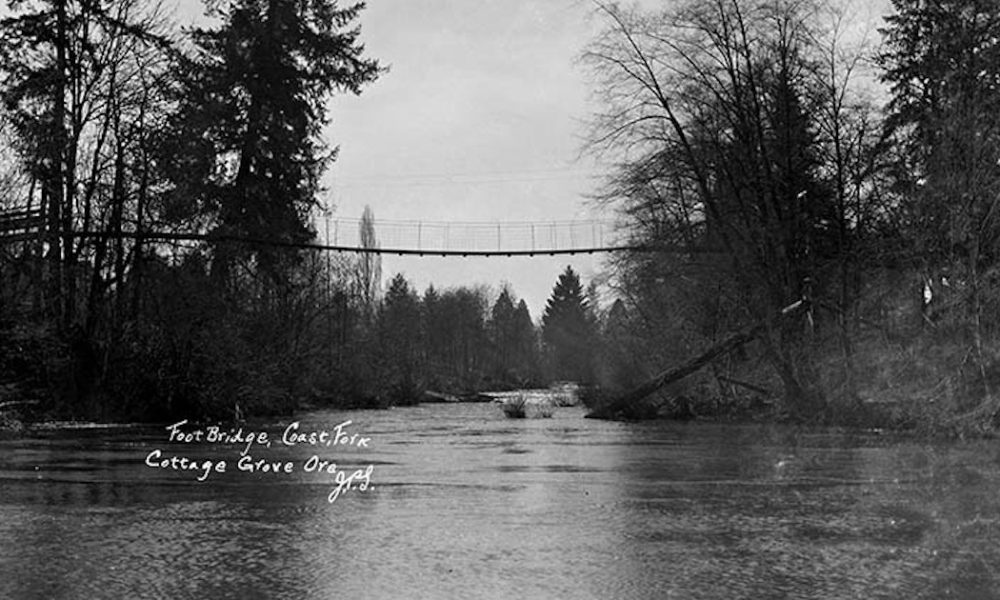 The first Cottage Grove ”Swinging Bridge,” circa 1925. PHOTO PROVIDED/COTTAGE GROVE HISTORICAL MUSEUM
The first Cottage Grove ”Swinging Bridge,” circa 1925. PHOTO PROVIDED/COTTAGE GROVE HISTORICAL MUSEUM
The Cottage Grove City Council is in a funny position in dealing with a ”new” old bridge with a hazy naming history. Their job is now to agree on an official name to what everyone calls the ”Swinging Bridge.”
It has crossed the Coast Fork of the Willamette for 119 years. Connecting Madison Avenue on the east bank to River Road on the west, this bridge was relocated downstream to its present location in 1917. The Cottage Grove Sentinel documented a design change that gave rise to the moniker ”Swinging Bridge.”
In the Oct. 18, 1917 edition, under the heading ”Currin Foot Bridge is Suspension Type” is the following account: ”The work of reconstructing the Currin foot bridge on the south side has been completed. The bridge was moved to a point directly in front of the L.S. Hill property and was changed to the suspension type of structure. It is thought that this will be much more permanent than the regular type of bridge, which had frequently to be rebuilt. J.P. Currin superintended the work of construction.”
This J. Polk Currin whose name was attached to the bridge, and who made sure the bridge at the new location went in right, was a pioneer druggist and also a regular town busybody. Besides running his drugstore on the west bank of the river in Slabtown, he was involved in early Cottage Grove education, set up a park and, probably without permission, built a footbridge across the river in 1900.
An issue of the Bohemia Nugget of that year contains a short piece stating that Currin had built a bridge connecting his drugstore to the park across the river bearing his name. Old postcards show this first version as a wooden trestle bridge with nary a swing to it.
Starting in 1909, articles littered The Sentinel and Cottage Grove Leader with tales of closures and committee meetings dealing with an unsafe bridge. Being uncovered and exposed to the elements there was nothing preventing the wooden bridge from rotting out, leading to repeated repairs.
The move downstream and the change to the suspension design were viewed as a solution to this maintenance problem. And by suspension we aren’t talking about overhead suspender cables holding the decking, but rather two taut cables covered with boards and some handrails. I believe that is when the ”swinging” term entered the conversation.
Fast-forward through at least three other versions of suspension bridges to December, 1964, when Cottage Grove and the rest of Oregon was settling in for Christmas and the floodwaters began to rise. A deep snowfall followed by a warm, two-week rain deluge sent so much water into the rivers that the dams, even with the floodgates wide open, couldn’t do much. Besides houses, bridges and crops, the holiday-dampening floodwaters swept away the then-version of the Currin suspension footbridge.
A number of locals tell discreetly of certain neighborhood kids who, in a youthful act of adventure, were out on the bridge bouncing it off the flood-stage waters when one bounce too deep allowed the current to grab the bridge and tear it from its moorings. Luckily the perpetrators were able to escape with their lives, even as the bridge was swept downstream.
Then-city engineer, Roger Sinclair, designed the replacement bridge and local contractor Carl Rich built it in time for a grand opening during the 1965 Bohemia Mining Days. The City Council officially named it after the original builder and creator, J.P. Currin and directed the Prospectors & Gold Diggers to attend to the opening.
That bridge held up pretty well with a few repairs over the years, but after 51 years its luck ran out. A routine inspection turned up that old enemy, rot, and the recurring theme of Currin Bridge closure for safety reasons came back to haunt us.
Now, three years later, work is wrapping up on yet another footbridge and this time it is being built to last. Steel towers that will rust, giving it both a protective coating and a wood-like patina, and marine-grade decking will ensure that we won’t be doing any rebuilds in our lifetimes. The design team of the Ausland Group, some of whom worked on our Chambers Railroad Bridge, listened to citizen concerns about how important it was that the bridge look and especially ”feel” like the one we are used to.
After poring over city records, the naming issue was looked into and as a result, also considered is the existence of another bridge in the area bearing the name Currin: a covered bridge. The issue was brought before the City Council at its Sept. 23 meeting without an agreement being reached. It was decided to pursue a three-pronged research process: contact the Cottage Grove Historical Society for input; investigate if there are any Currin descendants still in the area; and lastly, seek suggestions from the public.
That is where you readers come in. Here are four ways that you suggest a name for the bridge: 1.) you can fill out a form at City Hall; 2.) you can use the online survey at https://www.surveymonkey.com/r/2ZSMWW7; 3.) you can contact your ward’s city councilor or either or both of the two at-large city councilors; or 4.) show up at 7 p.m. next Monday, Oct. 14 at City Hall to voice your suggestion in public.
Regardless of the Council’s decision, it’s just an official name that will go on the dedication plaque and on maps. Chances are that everyone will still refer to it as the ”Swinging Bridge” regardless of any official naming. But it is still fun to bandy about lots of ideas and to reflect on over 100 years of history begun by Mr. J. Polk Currin when he decided to build a pedestrian bridge to connect two sides of Cottage Grove.
– – – – –
Dana Merryday is a Chronicle contributor and can be reached at 541-942-7037 and [email protected].








